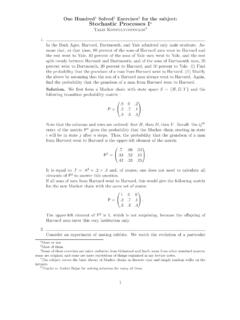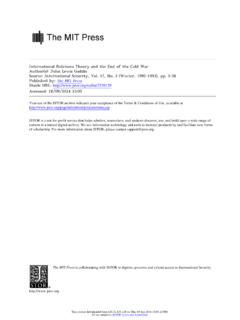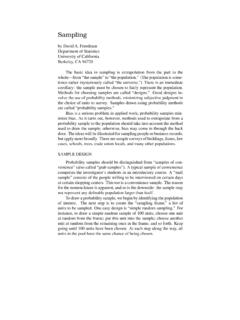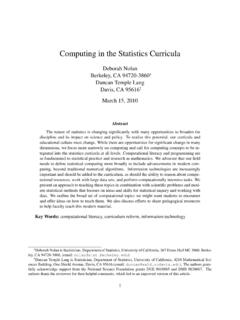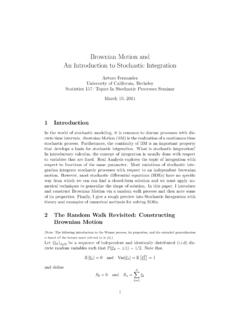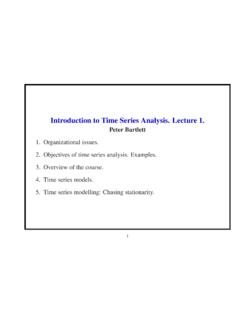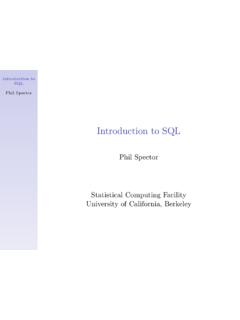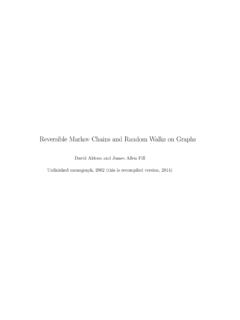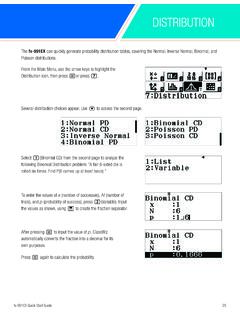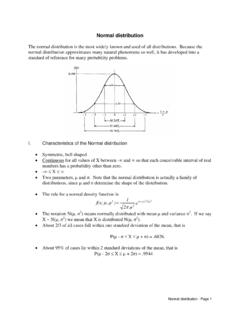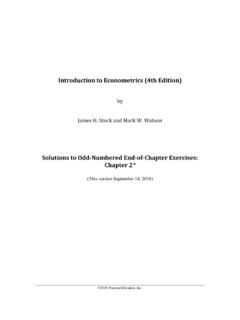Transcription of 1 Why is multiple testing a problem?
1 Spring 2008 - Stat C141/ Bioeng C141 - Statistics for BioinformaticsCourse Website: Website: Contact Info:Megan Hours: 342 Evans M 10-11, Th 3-4, and by appointment1 Why is multiple testing a problem? Say you have a set of hypotheses that you wish to test simultaneously. The first idea thatmight come to mind is to test each hypothesis separately, using some level of significance .At first blush, this doesn t seem like a bad idea. However, consider a case where you have20 hypotheses to test, and a significance level of What s the probability of observingat least one significant result just due to chance?P(at least one significant result) = 1 P(no significant results)= 1 (1 )20 , with 20 tests being considered, we have a 64% chance of observing at least one sig-nificant result, even if all of the tests are actually not significant.
2 In genomics and otherbiology-related fields, it s not unusual for the number of simultaneous tests to be quite abit larger than and the probability of getting a significant result simply due to chancekeeps going for dealing with multiple testing frequently call for adjusting in some way, sothat the probability of observing at least one significant result due to chance remains belowyour desired significance The Bonferroni correctionThe Bonferroni correction sets the significance cut-off at /n. For example, in the exampleabove, with 20 tests and = , you d only reject a null hypothesis if the p-value is lessthan The Bonferroni correction tends to be a bit too conservative. To demonstratethis, let s calculate the probability of observing at least one significant result when using thecorrection just described:1P(at least one significant result) = 1 P(no significant results)= 1 (1 )20 , we re just a shade under our desired level.
3 We benefit here from assumingthat all tests are independent of each other. In practical applications, that is often not thecase. Depending on the correlation structure of the tests, the Bonferroni correction could beextremely conservative, leading to a high rate of false The False Discovery RateIn large-scale multiple testing (as often happens in genomics), you may be better served bycontrolling the false discovery rate (FDR). This is defined as the proportion of false positivesamong all significant results. The FDR works by estimating some rejection region so that,on average, FDR< .4 The positive False Discovery RateThe positive false discovery rate (pFDR) is a bit of a wrinkle on the FDR. Here, you try tocontrol the probability that the null hypothesis is true, given that the test rejected the method works by first fixing the rejection region, then estimating , which is quitethe opposite of how the FDR is handled.
4 For gory levels of detail, see the Storey paper theprofessor has linked to from the class Comparing the threeFirst, let s make some data. For kicks and grins, we ll use the random normals in such a waythat we ll know what the result of each hypothesis test should <- c(rnorm(900), rnorm(100, mean = 3))p <- pnorm(x, = F)These functions should all be familiar from the first few weeks of class. Here, we ve madea vector, x, of length 1000. The first 900 entries are random numbers with a standard normaldistribution. The last 100 are random numbers from a normal distribution with mean 3 andsd 1. Note that I didn t need to indicated the sd of 1 in the second bit; it s the default second line of code is finding the p-values for a hypothesis test on each value of x. Thehypothesis being tested is that the value of x is not different from 0, given the entries aredrawn from a standard normal distribution.
5 The alternate is a one-sided test, claiming thatthe value is larger than , in this case, we know the truth: The first 900 observations should fail to rejectthe null hypothesis: they are, in fact, drawn from a standard normal distribution and any2difference between the observed value and 0 is just due to chance. The last 100 observationsshould reject the null hypothesis: the difference between these values and 0 is not due tochance s take a look at our p-values, adjust them in various ways, and see what sort of resultswe get. Note that, since we all will have our own random vectors, your figures will probablybe a different from mine. They should be pretty close, No correctionstest <- p > (test[1:900])summary(test[901:1000])The two summary lines will give me a count of how many p-values where above andbelow.
6 05. Based on my random vector, I get something that looks like this:> summary(test[1:900])Mode FALSE TRUE logical 46 854> summary(test[901:1000])Mode FALSE TRUE logical 88 12 The type I error rate (false positives) is 46/900 = The type II error rate (falsenegatives) is 12/100 = Note that the type I error rate is awfully close to our , isn t a coincidence: can be thought of as some target type I error Bonferroni correctionWe have = , and 1000 tests, so the Bonferroni correction will have us looking forp-values smaller than :> bonftest <- p > > summary(bonftest[1:900])Mode FALSE TRUE logical 1 899> summary(bonftest[901:1000])Mode FALSE TRUE logical 23 77 Here, the type I error rate is 1/900 = , but the type II error rate has skyrocketedto We ve reduced our false positives at the expense of false negatives.
7 Ask yourself:which is worse? False positives or false negatives? Note: there isn t a firm answer. It reallydepends on the context of the problem and the consequences of each type of FDRFor the FDR, we want to consider the ordered p-values. We ll see if the kth ordered p-valueis larger thank . <- sort(p)fdrtest <- NULLfor (i in 1:1000)fdrtest <- c(fdrtest, p[i] > match(p[i],psort) * .05/1000)Let s parse this bit of code. I want the string of trues and falses to be in the same orderas the original p-values, so we can easily pick off the errors. I start by creating a separatevariable, psort, which holds the same values as p, but sorted from smallest to largest. Say Iwant to test only the first entry of p:> p[1] > match(p[1],psort) * .05/1000[1] TRUEp[1] picks off the first entry from the vector p. match(p[1],psort) looks through the vectorpsort, finds the first value that s exactly equal to p[1], and returns which entry of the vectorit is.
8 In my random vector, match(p[1], psort) returns 619. That means that, if you put allthe p-values in order from smallest to largest, the 619th largest value is the one that appearsfirst in my vector. The value you get might differ pretty wildly in this case. Anyhow, on tosee how the errors go:> summary(fdrtest[1:900])Mode FALSE TRUE logical 3 897> summary(fdrtest[901:1000])Mode FALSE TRUE logical 70 30 Now we have a type I error rate of 3/900 = The type II error rate is now 30/70= , a big improvement over the Bonferroni correction! pFDRThe pFDR is an awful lot more involved, coding-wise. Mercifully, someone s already writtenthe package for us.> library(qvalue)> pfdrtest <- qvalue(p)$qvalues > .05 The qvalue function returns several things. By using$qvalues after the function, it sayswe only really want the bit of the output they call qvalues.
9 4> summary(pfdrtest[1:900])Mode FALSE TRUE logical 3 897> summary(pfdrtest[901:1000])Mode FALSE TRUE logical 70 30I seem to get the same results as in the regular FDR, at least at the 5% level. Let s takea look at the cumulative number of significant calls for various levels of and the 188 Bonferroni0613212431 FDR01944637391pFDR02048647393 Here s how the type I errors and type II
